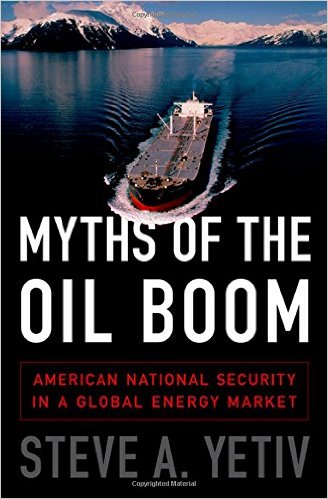Myths of the Oil Boom
A case for shaking the oil habit.
Myths of the Oil Boom: American National Security in a Global Energy Market. By Steve A. Yetiv. Oxford University Press, New York, 2015. 272 pp.
Even the most casual of news observers would be hard pressed to disagree with the opening of Steve A. Yetiv’s argument: oil is “by far the most important energy source in the world.” Crude oil and its refined byproducts fuel the global economy. The vast majority of vehicle driving worldwide—private, governmental, commercial—is done with an internal combustion engine that runs on gasoline or diesel. In many places, it is the main source of heat for private homes. Of the top ten companies by revenue worldwide, half are in the oil and gas sector. In addition to being big business, oil is a geostrategic commodity. For the past forty years, the United States has been committed militarily to the Persian Gulf in an effort to ensure security of supply.
Issues affecting the global oil market have taken particular salience since the summer of 2014, as the price of crude oil has plunged—thanks in part to new supplies brought to market by a revolution in unconventional drilling in the United States, weakened global economic growth, and a decision by Saudi Arabia not to cut its own production. That latter policy change was widely interpreted as an effort to slow the U.S. oil boom.
The ripple effects of this price drop have been quite profound. Venezuela, an oil-producing nation that relies on high export prices to fund social spending at home, had to send its president on a world tour to seek foreign financial assistance to make up the shortfall. The government in Baghdad says low oil prices are hurting its fight against the Islamic State in Iraq and Syria, an extremist movement that partially funds its activities through the black market sale of oil under its control. In the United States, Alaska is facing serious declines in revenue from its oil and gas production tax, as companies have slowed projects in response to price constraints.
Yetiv’s book is thus well timed, as it aims to explain some of the fundamental issues that drive the global oil market, and the ways in which U.S. drilling has and has not shifted the market’s long-term trends. He outlines and then corrects several “myths”: that U.S. presidents can control the global price of oil, that more oil produced in the United States means a lowering of our involvement in the Middle East, or that big multinational oil companies dominate the market. He clearly explains how unconventional drilling—methods such as hydraulic fracturing or horizontal drilling, which were not widely used even as recently as five years ago—is not solely responsible for the current low-price environment. Rather, he argues, it took a “perfect storm” including other factors as well: additional supply landing in a market that was seeing less than typical demand; and the Organization of Petroleum Exporting Countries (OPEC) defying the conventional wisdom of market watchers by not cutting production to preserve a higher price band.
Busted myths are a useful reminder that in the global oil market, a measure of uncertainty should underpin any calculation about the future. Even with a strategic commodity such as oil, where nation states jockey for advantage, the laws of supply and demand have a pesky way of asserting themselves over the best-laid plans. As a result, as revolutionary as the U.S. advances in unconventional oil production have been, they do not guarantee insulation from a market reaction. Already, the economics of these projects are being challenged by the unwillingness of Saudi Arabia to cut its own production, even as the price of crude oil has dipped below their budgetary break-even point (the point at which oil prices will generate enough revenue to cover government expenditure). The market is resetting, and no one can say with real confidence what the industry will look like even in a year’s time.
These discussions lead Yetiv to his larger goal: convincing Americans that the myriad benefits of the domestic oil boom, which already have a tendency to be exaggerated, are no excuse for avoiding long-term planning to reduce global oil consumption. If more U.S. production cannot guarantee energy self-sufficiency and insulation from the vagaries of a global market, he argues, then reducing the role that oil plays in the global economy should be the proper goal. As long as oil is an essential economic input, the international community will be invested in its exploration and production, with various political, social, and economic consequences. Would it not be better for American energy security, Yetiv proposes, if the United States led the charge to reduce worldwide oil consumption, rather than focus exclusively on continuing the drilling?
It is a worthwhile goal, and certainly necessary if the planet is to avoid the worst effects of climate change. But Yetiv’s policy prescriptions here lack a sense of robustness. For example, there is currently no appetite, even from the otherwise environmentally conscious Obama administration, to raise the gas tax in the United States. Research and development in hybrid and electric vehicles continues, but it is not clear whether an accelerated effort, which Yetiv calls for, would make much headway in the current low-price environment—people buy these kinds of cars when gasoline is expensive.
At the international level, there is some optimism, as many countries are taking advantage of low crude prices to roll back wasteful fossil fuel subsidies which, ceteris paribus, would decrease consumption as more people pay closer to the market price. More international coordination on subsidy reform in the oil and gas industry, which the International Monetary Fund has championed, would be one crucial step. But the kind of “moonshot” reduction that Yetiv seeks is unlikely to materialize. With crude prices hovering at their lowest, outside of a period of global recession, in a decade, the political will necessary to spearhead that level of international coordination is nonexistent. Calls for that kind of activism were much more prevalent in the mid-2000s, when oil prices were much higher (West Texas intermediate topped out at $133 per barrel in July 2008), but even then, action never followed the talk. Unfortunately, this state of affairs guarantees decades more of the kind of market and geopolitical uncertainty spotlighted in this book.
Neil Bhatiya is a policy associate at the Century Foundation, focusing on U.S. foreign policy in South Asia. He was previously a research fellow at the Streit Council for a Union of Democracies. On Twitter: @NeilBhatiya.





